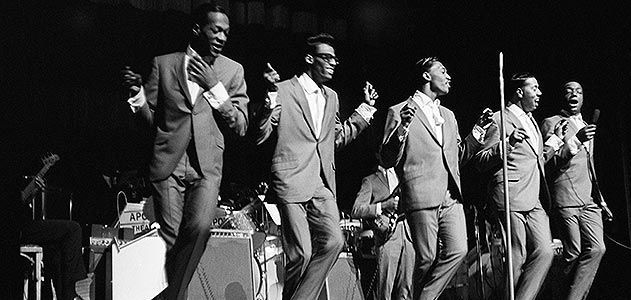Caption: The Temptations performing at the Apollo Theater.
The Temptations were pictured performing at the Apollo Theater in New York City in 1964. Their polished dress, synchronized choreography, and distinct harmonies were the characteristics that were unique to them and the Motown Records record label (Holmes 2009). During their performance of "ABC" on American Bandstand, the Jackson 5 look visually different from The Temptations. Although they appear in a line at first, the clothing and dancing from the Jackson 5 members show a new degree of freedom.
Prior to the turn of the decade, Motown Records was responsible for the production of very polished and rehearsed performers and records. The staff, artists, and work of those connected to the record label were held to the same high level of expectation that created the distinctive Motown sound. Prior to The Jackson 5, female and male groups dressed minimalistically so the focus of any performance could be on their vocal abilities. As African-Americans in a white American dominated industry, their skill levels were exaggerated by physical and musical synchronization. When the members of a particular group performed identically, that was appealing and respected by an audience. Motown Records owner, Berry Gordy Jr., was in tune with American pop culture and was able to train his musicians in a way that was reflective of the standards inside and out of “Hitsville U.S.A.”

Caption: Photo of Jackson 5. CIRCA 1970. Photo by Michael Ochs Archives/Getty Images.
Each of the members of the Jackson 5 are showing off their Afro hairstyles in the picture above (Dickerson, 2017). With all members having Afros, there is a unity created within the group. While this may indicate an old Motown style, the Afro is actually a rebellious tool.
As the Jackson 5 made their way to the top of many music charts, the attention on their musicianship was shared with that of their physical appearance. The clothing and hair choices of the members were different from what white audiences were used to. They were also different from what was associated with Berry Gordy’s brand. During each performance, every individual member of the quintet wore articles of clothing that were similar, but not truly identical. This unseen physical freedom was intensified with the natural Afro hairstyle (Chinwe). These subtle changes allowed Motown Records to develop a voice in social consciousness and political activism during the 1970s (Sykes, p. 7). The record label and its artists were moving in a direction towards inclusivity and diversity which allowed the brother singing group to be a representation of hope for all ages of listeners in America.
Caption: Allure, a beauty magazine, released a video on their YouTube channel discussing Black hairstyles.
The video above depicts the evolution of hair in the Black community. During the 1960s (1:05m) the Afro became a symbol of social and political rejection. Especially during the Civil Rights Movement, natural hair was used as a weapon of rebellion. While it was becoming fashionably acceptable in the 1970s, it still carried great power as a social and political statement (Allure).

